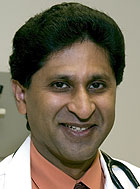The School of Medicine has joined the Multiple Myeloma Research Consortium (MMRC), an organization of 13 leading U.S. academic centers designed to speed the development of new myeloma therapies.
The School of Medicine serves as a major center for multiple myeloma treatment and research in the St. Louis area.

“As a member of the MMRC, we can provide our patients with access to novel medications that would not otherwise be available,” said Ravi Vij, M.D., assistant professor of medicine in the Division of Oncology and a medical oncologist with the Siteman Cancer Center. “The unfortunate truth about multiple myeloma is that so far it is incurable. Treatments can work for a while, but they all eventually stop working. That’s when it becomes very important for patients to be able to enroll in clinical trials for new therapies.”
Multiple myeloma is the second most common blood cancer. With improvements in therapy, patients are living longer with the disease, causing it to be more prevalent. About 50,000 people in the United States are living with multiple myeloma, and an estimated 19,900 new cases of the disease are expected to be diagnosed in 2007.
“Multiple myeloma treatment is rapidly undergoing a revolution,” Vij said. “In the ’80s, the median length of survival after diagnosis was about three years. Now with the use of stem cell transplantation and three very active drugs — thalidomide, Revlimid and Velcade — patients often are surviving more than six or seven years.”
A number of emerging therapies — including novel proteosome inhibitors, immunomodulatory drugs, histone deacetylase inhibitors, heat shock protein inhibitors and many other classes of drugs in development — may offer hope when standard treatments fail.
Founded in 2004 by Kathy Giusti, a myeloma patient and chief executive officer of the Multiple Myeloma Research Foundation, the MMRC has created many opportunities in myeloma research and drug development that did not exist just a few years ago.
The MMRC facilitates collaborative research between biotechnology and pharmaceutical companies and academic research institutions. This research is solely directed toward creating new and effective treatments and to ensure progress toward a cure for myeloma.
“This is a unique endeavor that has not yet been tried in other spheres of cancer research,” Vij said.
MMRC researchers benefit from having a large patient base and a critical mass of tissue samples, making it easier to identify and validate molecular targets for myeloma as well drugs that are active against these targets. In addition, the MMRC will connect patients with early clinical trials evaluating promising new therapies, both alone and in combination with standard myeloma therapies, to ensure that new treatments are brought to market as quickly as possible.